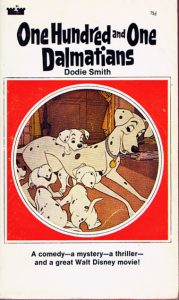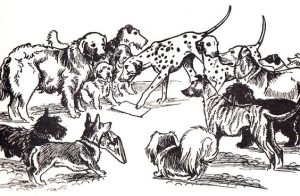
Monday Morning School was the perfect excuse to read One Hudred and One Dalmatians again. Though the story-line was fuzzy in my memory, not so the nostalgia for the days home alone, missing school because of a cold; couch, blanket, box of Kleenex, reading and rereading this sweet tale.
Because the feeling of reading this one stuck with me longer than the details did, I wondered if it would seem weak and silly now. It doesn’t. According to a master storyteller, if it was a good book when I was 10, and is still good now that I’m over 50, it must be a good book.
As I’ve remarked in other reviews of some of my favorite books from childhood, it’s difficult to put my finger directly on why I was so crazy about animal stories. Each time I read one of them again, it becomes a little more clear. I think. Pondering which is relevant here because the day after I finished the book, I watched Disney’s 1961 cartoon interpretation. Noting what Disney added and subtracted helps identify the qualities that make the book so appealing.
This book is about the dogs, not the people. Smith scarcely spends an entire page giving us the history of how the dog couple and the human couple got together before the saga commences. Mr. Dearly was Pongo’s “pet;” Mrs. Dearly was Misses’s “pet.” Shortly after the double wedding, Misses (Perdita is actually the name of another dog in the story) gives birth to 15 puppies. The author even arranges for the Dearlys to be newly wealthy right at the beginning, thus removing any concern about what they will do when they suddenly find themselves owned by 101 dogs. All the puppies’ parents have to do is get everyone home. The humans will take it from there.

Cruella de Vil, the villain of the piece, is introduced in the first chapter, and we know for sure that she’s bad news. Though someone has to steal the puppies so we can have a daring rescue, the story isn’t about her either. Even Cruella’s henchmen, the Baddun brothers, figure only briefly in the puppies’ initial escape. The bumbling sidekicks have to be shooed off stage to make way for the true antagonists; fear, separation, cold, hunger, and exhaustion.
What we want are brave animals performing daring feats for a noble cause. Smith rolls out a cast of major and minor players, without whom Pongo and Misses could never have accomplished the rescue. Most of these characters are either missing entirely from the cartoon or perform their roles with as much personality as paper cut-outs.
It probably goes without saying that One Hundred and One Dalmatians isn’t an animal story along the lines of The Call of the Wild, with the animals acting strictly according to nature. But, neither are these animals dressed, talking, and living like humans. Smith achieves a pleasant balance between the two options. A rare few of the dogs can read. Some understand all human speech, but others only know a little. Pongo has a particularly brilliant mind, but even he can’t do anything that requires fingers or opposable thumbs.
The Disney cartoon couldn’t resist the usual bag of tricks, the stock villain as main character; ever-present incompetent accomplices; fast-paced, drawn-out, bungled chase. What the audience misses out on is a real sense of the bravery and endurance the dogs exhibit in the book. The network of animals whose daring and sacrifice make the mission possible is minimized for the sake of time and pacing. Though I could go on and on with a movie critique, the real purpose of comparing the cartoon with the book is to let you know that, if you’ve only seen the cartoon, you can look forward to discovering the heart of Dodie Smith’s dogtale when you read the book.
Listen in to Our Reading Life Book Club Discussion, here.